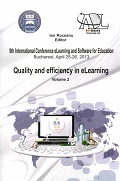INTEGRATING AUDIOVISUAL PRACTICES IN THE DESIGN OF ONLINE COURSES OF LABORATORY OF PHYSICS
INTEGRATING AUDIOVISUAL PRACTICES IN THE DESIGN OF ONLINE COURSES OF LABORATORY OF PHYSICS
Author(s): Ahmetaga Shpresa, Mario Allegra, Edlira PrenjasiSubject(s): Education
Published by: Carol I National Defence University Publishing House
Keywords: collaborative learning; audiovisual practices; online courses; laboratory of physics; elearning
Summary/Abstract: The laboratory courses are an important part of physics studies. Their program includes performing essential experiments of classical and modern physics that verify the laws of physics, which students learn on the other courses. During the development of the laboratory work, students have the opportunity to gain hands-on experience with experimental techniques and to gain better understanding of the relationship between experiment and theory. Laboratory work represents a typical case of collaborative learning because it is carried out by a group made of three or four students usually. At the same time, it is an appropriate activity for the combination with audiovisual practices, that can enhance the learning experience by showing places and phenomena that otherwise could not be seen, or by allowing the demonstration of procedural activities in detail. The research done shows us that at the multimedia age, the audiovisual practices can be used to support learning, e-learning, mobile learning, distance and blended learning, etc. Also, our students, the so-called "digital native", are now producers of videos, animations, interactive presentations, etc. Therefore, throughout the design of online courses of Laboratory of Physics, at the Department of Physics of University "L. Gurakuqi" of Shkoder, in Albania, we planned to combine the traditional approach with audiovisual practices, aiming to make students feel protagonists on the construction of their laboratory paths, to highlight their creativity and expressiveness, to reinforce their collaboration inside the groups. This paper will describe the results of the experience. The data has been collected through interviews composed of open ended questions.
Journal: Conference proceedings of »eLearning and Software for Education« (eLSE)
- Issue Year: 9/2013
- Issue No: 02
- Page Range: 344-349
- Page Count: 6
- Language: English

